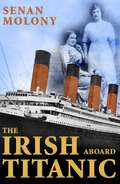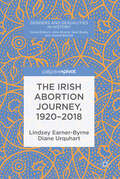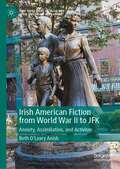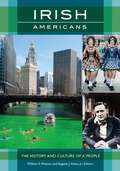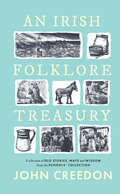- Table View
- List View
Irish: The Remarkable Saga of a Nation and a City
by John BurrowesIrish is the story of the mass migration from Ireland to Glasgow that took place in the wake of the Great Famine of the mid-nineteenth century. It is an epic account of the coming together of a nation and a city. This is the tale of those who escaped a nightmare existence in the poorest and most deprived country in Europe and changed the city of Glasgow forever. Irish brings to life the horrot of those grim days and reveals the unimaginable suffering endured as a result of the Potatoe Blight. It describes in vivid detail the hazards and hardships faced by those fleeing Ireland in search of a better life overseas, including a startling account of one of the most deplorable maritime crimes ever committed, the voyage of the SS Londonderry. The coming of the Irish to Glasgow had a bigger impact on the city than other event. Now, for the first time, the truth about this most significant and stirring episode is vividly unfolded. It tells of the contribution made by Irish labourers in Glasgow to the Industrial Revolution; reveals that the legendary football clubs of Celtic and Rangers may never have existed were it not for the migrant's arrival; and describes the "Partick War", and the occasion of the first-ever Orange Walk.
The Irish Aboard Titanic: One Of Ireland's Favourite Writers
by Senan MolonyThe unspeakable tragedy of the Titanic disaster can only be fully appreciated through the tales of the people who were aboard on the night the ship went down. The Irish Aboard Titanic gives those people a voice, focusing on the Irish who were aboard the 'unsinkable' liner. In it are stories of agony, luck, self-sacrifice, dramatic escapes and heroes left behind. Senan Molony also records the heartache that continued long after that fateful night. In her wake the Titanic cast a long shadow over the families forced to endure the agonising wait to learn the fate of loved ones, over the lives of the survivors who had to start their lives anew and over those who lost relatives and friends. If you want to know about the Irish passengers and crew of the Titanic, this is the only book to have.
The Irish Abortion Journey, 1920–2018 (Genders and Sexualities in History)
by Lindsey Earner-Byrne Diane UrquhartThis book reframes the Irish abortion narrative within the history of women’s reproductive health and explores the similarities and differences that shaped the history of abortion within the two states on the island of Ireland. Since the legalisation of abortion in Britain in 1967, an estimated 200,000 women have travelled from Ireland to England for an abortion. However, this abortion trail is at least a century old and began with women migrating to Britain to flee moral intolerance in Ireland towards unmarried mothers and their offspring. This study highlights how attitudes to unmarried motherhood reflected a broader cultural acceptance that morality should trump concerns regarding maternal health. This rationale bled into social and political responses to birth control and abortion and was underpinned by an acknowledgement that in prioritising morality some women would die.
Irish American Fiction from World War II to JFK: Anxiety, Assimilation, and Activism (New Directions in Irish and Irish American Literature)
by Beth O’Leary AnishIrish American Fiction from World War II to JFK addresses the concerns of Irish America in the post-war era by studying its fiction and the authors who brought the communities of their youth to life on the page. With few exceptions, the novels studied here are lesser-known works, with little written about them to date. Mining these tremendous resources for the details of Irish American life, this book looks back to the beginning of the twentieth century, when the authors' immigrant grandparents were central to their communities. It also points forward to the twenty-first century, as the concerns these authors had for the future of Irish America have become a legacy we must grapple with in the present.
Irish Americans: The History and Culture of a People
by William E. Watson Eugene J. HalusVirtually every aspect of American culture has been influenced by Irish immigrants and their descendants. This encyclopedia tells the full story of the Irish-American experience, covering immigration, assimilation, and achievement.The Irish have had a significant impact on America across three centuries, helping to shape politics, law, labor, war, literature, journalism, entertainment, business, sports, and science. This encyclopedia explores why the Irish came to America, where they settled, and how their distinctive Irish-American identity was formed. Well-known Irish Americans are profiled, but the work also captures the essence of everyday life for Irish-Americans as they have assimilated, established communities, and interacted with other ethnic groups.The approximately 200 entries in this comprehensive, one-stop reference are organized into four themes: the context of Irish-American emigration; political and economic life; cultural and religious life; and literature, the arts, and popular culture. Each section offers a historical overview of the subject matter, and the work is enriched by a selection of primary documents.
Irish Americans: The History and Culture of a People
by William E. Watson Eugene J. Halus Jr.Virtually every aspect of American culture has been influenced by Irish immigrants and their descendants. This encyclopedia tells the full story of the Irish-American experience, covering immigration, assimilation, and achievement.The Irish have had a significant impact on America across three centuries, helping to shape politics, law, labor, war, literature, journalism, entertainment, business, sports, and science. This encyclopedia explores why the Irish came to America, where they settled, and how their distinctive Irish-American identity was formed. Well-known Irish Americans are profiled, but the work also captures the essence of everyday life for Irish-Americans as they have assimilated, established communities, and interacted with other ethnic groups.The approximately 200 entries in this comprehensive, one-stop reference are organized into four themes: the context of Irish-American emigration; political and economic life; cultural and religious life; and literature, the arts, and popular culture. Each section offers a historical overview of the subject matter, and the work is enriched by a selection of primary documents.
The Irish and the Origins of American Popular Culture (Routledge Studies in Cultural History #57)
by Christopher DowdThis book focuses on the intersection between the assimilation of the Irish into American life and the emergence of an American popular culture, which took place at the same historical moment in the late 19th and early 20th centuries. During this period, the Irish in America underwent a period of radical change. Initially existing as a marginalized, urban-dwelling, immigrant community largely comprised of survivors of the Great Famine and those escaping its aftermath, Irish Americans became an increasingly assimilated group with new social, political, economic, and cultural opportunities open to them. Within just a few generations, Irish-American life transformed so significantly that grandchildren hardly recognized the world in which their grandparents had lived. This pivotal period of transformation for Irish Americans was heavily shaped and influenced by emerging popular culture, and in turn, the Irish-American experience helped shape the foundations of American popular culture in such a way that the effects are still noticeable today. Dowd investigates the primary segments of early American popular culture—circuses, stage shows, professional sports, pulp fiction, celebrity culture, and comic strips—and uncovers the entanglements these segments had with the development of Irish-American identity.
The Irish and the Origins of American Popular Culture (Routledge Studies in Cultural History #57)
by Christopher DowdThis book focuses on the intersection between the assimilation of the Irish into American life and the emergence of an American popular culture, which took place at the same historical moment in the late 19th and early 20th centuries. During this period, the Irish in America underwent a period of radical change. Initially existing as a marginalized, urban-dwelling, immigrant community largely comprised of survivors of the Great Famine and those escaping its aftermath, Irish Americans became an increasingly assimilated group with new social, political, economic, and cultural opportunities open to them. Within just a few generations, Irish-American life transformed so significantly that grandchildren hardly recognized the world in which their grandparents had lived. This pivotal period of transformation for Irish Americans was heavily shaped and influenced by emerging popular culture, and in turn, the Irish-American experience helped shape the foundations of American popular culture in such a way that the effects are still noticeable today. Dowd investigates the primary segments of early American popular culture—circuses, stage shows, professional sports, pulp fiction, celebrity culture, and comic strips—and uncovers the entanglements these segments had with the development of Irish-American identity.
Irish Blessings Toasts & Curses
by Padraic O'FarrellIrish people have blessings, toasts, and curses for every occasion and are renowned for yarns and stories. They have a gift of the gab which may come from kissing The Blarney Stone! This collection of humourous quotations is full of wit and merriment but the sayings come from times of revolution, famine, and hardship. This volume is a treasure trove of blessings, toasts, and curses and is an ideal gift for those of Irish heritage seeking to celebrate St. Patrick's Day (or St Patty's Day!) and St Brigid's day, which is now a national bank holiday in Ireland.
Irish Blessings Toasts & Curses
by Padraic O'FarrellIrish people have blessings, toasts, and curses for every occasion and are renowned for yarns and stories. They have a gift of the gab which may come from kissing The Blarney Stone! This collection of humourous quotations is full of wit and merriment but the sayings come from times of revolution, famine, and hardship. This volume is a treasure trove of blessings, toasts, and curses and is an ideal gift for those of Irish heritage seeking to celebrate St. Patrick's Day (or St Patty's Day!) and St Brigid's day, which is now a national bank holiday in Ireland.
Irish Blood, English Heart, Ulster Fry: Return Journeys to Ireland
by Annie CaulfieldAnnie Caulfield's early years were spent by the seaside in Ireland. However, the family shifted to Sixties London and soon she wasn't sure who she was - was she English, was she Irish, and if so, what kind of Irish? Watching the news of The Troubles, she was unable to recognise the country she'd left behind. On return journeys to visit her family over the last thirty years, she discovers how much The Troubles have caused weird and successful aspects of the country's life and history to be overlooked. Caulfield's background is religiously and politically mixed, giving her a unique and often astute perspective on The Troubles. This is an Irish emigrant's tale, asking whether you can ever really go back to your roots. If you were a punk rocker when others were on hunger strike, can you really put your hand on your heart and say 'my people'? If you get a headache and go home to watch Big Brother on 12th July, are you just too flippant to understand your own country? There are many books on the recent history of Northern Ireland, but none give such a funny insight into the lives of ordinary people as Annie Caulfield's affectionate portrait of 'Alternative Ulster'.
The Irish Diaspora in Britain, 1750-1939 (Social History in Perspective)
by Donald MacRaildThis established study focuses on the most important phase of Irish migration, providing analysis of why and how the Irish settled in Britain in such numbers. Updated and expanded, the new edition now extends the coverage to 1939 and features new chapters on gender and the Irish diaspora in a global perspective.
The Irish Diaspora in Britain, 1750-1939 (Social History in Perspective)
by Donald MacRaildThis established study focuses on the most important phase of Irish migration, providing analysis of why and how the Irish settled in Britain in such numbers. Updated and expanded, the new edition now extends the coverage to 1939 and features new chapters on gender and the Irish diaspora in a global perspective.
The Irish Fairy Book: Myth And Romance From The Old World (Celtic, Irish Ser.)
by Alfred Perceval Graves George DenhamLeprechauns, fairies, and other mythical figures inhabit this entertaining collection of Irish fairy lore. The rich and representative collection of 43 tales and poems includes "The Stolen Child," a beguiling poem by William Butler Yeats; "The King of the Black Desert," by poet, scholar, and statesman Douglas Hyde; Lady Jane Wilde's "The Horned Women" and "The Demon Cat," as well as works by Joseph Campbell, Jeremiah Curtin, Alfred Lord Tennyson, Patrick Kennedy, and other distinguished writers. A valuable resource for students of Celtic lore, The Irish Fairy Book offers hours of enchanted reading for lovers of folktales.
Irish Fairy Legends (Celtic, Irish Ser.)
by T. Crofton CrokerCome sit by the fire — a world of enchantment awaits you in this treasury of classic Irish stories by folklorist T. Crofton Croker. From 1812 to 1816, he roamed southern Ireland, listening to his countrymen's stories of pixies, leprechauns, and other supernatural creatures. The result is one of the first collections of Irish fairy tales on record — and it's often considered the finest. Told in plain but colorful language with charming illustrations that capture the wonder of these tales, it became an overnight bestseller. An engaging mix of darkness and humor, the thirty-eight stories are filled to the brim with Irish wit and magic. In "The Haunted Cellar," you'll meet one of Ireland's oldest families, with blood as thick as buttermilk and a reputation for hospitality. But what is the secret in Justin Mac Carthy’s wine cellar that forces every butler to quit? In "The Changeling," a new mother finds a just solution when her infant is replaced by a mischievous fairy. "The Legend of Knockfierna" teaches fearless Carroll O'Daly a hard lesson about interfering with the "little people." And that's just a taste of the delights inside. A rich reflection of Celtic culture, Irish Fairy Legends will entertain you and your family for generations.
The 'Irish' Family
by Linda ConnollyWhen situated in the wider European context, ‘the Irish family’ has undergone a process of profound transformation and rapid change in very recent decades. Recent data cites a significant increase in one parent households and a high non-marital birth rate for instance alongside the emergence of cohabitation, divorce, same sex families and reconstituted families. At the same time, the majority of children in Ireland still live in a two-parent family based on marriage and the divorce rate in Ireland is comparatively lower than other European countries. 21st century family life is, in reality, characterised by continuity and change in the Irish context. This book seeks to understand, interpret and theorise family life in Ireland by providing a detailed analysis of historical change, demographic trends, fertility and reproduction, marriage, separation and divorce, sexualities, children and young people, class, gender, motherhood, intergenerational relations, grandparents, ethnicity, globalisation, technology and family practices. A comprehensive analysis of key developments and trends over the course of the twentieth and twenty-first centuries is provided.
The 'Irish' Family
by Linda ConnollyWhen situated in the wider European context, ‘the Irish family’ has undergone a process of profound transformation and rapid change in very recent decades. Recent data cites a significant increase in one parent households and a high non-marital birth rate for instance alongside the emergence of cohabitation, divorce, same sex families and reconstituted families. At the same time, the majority of children in Ireland still live in a two-parent family based on marriage and the divorce rate in Ireland is comparatively lower than other European countries. 21st century family life is, in reality, characterised by continuity and change in the Irish context. This book seeks to understand, interpret and theorise family life in Ireland by providing a detailed analysis of historical change, demographic trends, fertility and reproduction, marriage, separation and divorce, sexualities, children and young people, class, gender, motherhood, intergenerational relations, grandparents, ethnicity, globalisation, technology and family practices. A comprehensive analysis of key developments and trends over the course of the twentieth and twenty-first centuries is provided.
Irish Feminist Futures (Transformations)
by Claire BrackenThis book is about the future: Ireland’s future and feminism’s future, approached from a moment that has recently passed. The Celtic Tiger (circa 1995-2008) was a time of extraordinary and radical change, in which Ireland’s economic, demographic, and social structures underwent significant alteration. Conceptions of the future are powerfully prevalent in women’s cultural production in the Tiger era, where it surfaces as a form of temporality that is open to surprise, change, and the unknown. Examining a range of literary and filmic texts, Irish Feminist Futures analyzes how futurity structures representations of the feminine self in women’s cultural practice. Relationally connected and affectively open, these representations of self enable sustained engagements with questions of gender, race, sexuality, and class as they pertain to the material, social, and cultural realities of Celtic Tiger Ireland. This book will appeal to students and scholars of Irish studies, Irish feminist criticism, sociology, cultural studies, literature, women's studies, gender studies, neo-materialist and feminist theories.
Irish Feminist Futures (Transformations)
by Claire BrackenThis book is about the future: Ireland’s future and feminism’s future, approached from a moment that has recently passed. The Celtic Tiger (circa 1995-2008) was a time of extraordinary and radical change, in which Ireland’s economic, demographic, and social structures underwent significant alteration. Conceptions of the future are powerfully prevalent in women’s cultural production in the Tiger era, where it surfaces as a form of temporality that is open to surprise, change, and the unknown. Examining a range of literary and filmic texts, Irish Feminist Futures analyzes how futurity structures representations of the feminine self in women’s cultural practice. Relationally connected and affectively open, these representations of self enable sustained engagements with questions of gender, race, sexuality, and class as they pertain to the material, social, and cultural realities of Celtic Tiger Ireland. This book will appeal to students and scholars of Irish studies, Irish feminist criticism, sociology, cultural studies, literature, women's studies, gender studies, neo-materialist and feminist theories.
An Irish Folkore Treasury: A Selection of Old Stories, Ways and Wisdom from the Schools' Collection
by John CreedonIn The 1930s, Irish schoolchildren were tasked with asking their oldest relatives and neighbours about stories and superstitions from times past so that ordinary people’s lives could be preserved and celebrated. What those schoolchildren wrote in their copybooks resulted in the National Folklore Archive’s Schools’ Collection, and this book contains a selection of its best stories. With chapters on ghost stories, agriculture, forgotten trades, schooling and pastimes, this is a people’s history of Ireland.There are incredible stories of self-sufficiency from an era when everything on the table was homemade. Discover how people survived on flour, milk and potatoes, and how fabric, dye, soap and candles were made by hand. There are delightful memories of childhoods spent outdoors, gathering nuts and berries, playing Tig and fishing; while stories of folk remedies reveal how wellbeing in Ireland had long been a heady potion of miraculous medals, doctors, healers, holy wells and pilgrimages.With each chapter introduced and contextualised in John Creedon’s inimitable voice, this beautiful treasury of tales is a stunning tribute to ordinary Irish people and how they lived long ago.
Irish Immigrants and Scottish Society in the Nineteenth and Twentieth Centuries: Proceedings of the Scottish Historical Studies Seminar, University of Strathclyde, 1989/90
by T M DevineThe Irish were the single largest group of immigrants to Scotland in the nineteenth and twentieth centuries, and the original settlers and their descendants have had a major impact on modern Scottish society, culture and politics. This book of original studies is the first major reassessment of the general effect of Irish immigration on Scotland since the classic works of James Handley during the 1940s. All the contributors have produced significant research in the field, and the book provides a varied and balanced insight into current historical thinking on the Irish in Scotland.
The Irish in the Victorian City (Routledge Library Editions: The Victorian World #47)
by Roger Swift; Sheridan GilleyFirst published in 1985, this book explores the social history of the Irish in Britain across a variety of cities, including Bristol, York, Glasgow, Edinburgh and Stockport. With contributions from foremost scholars in the field, it provides a thorough critical study of Irish immigration, in its social, political, cultural and religious dimensions. This book will be of interested to students of Victorian history, Irish history and the history of minorities.
The Irish in the Victorian City (Routledge Library Editions: The Victorian World)
by Roger Swift Sheridan GilleyFirst published in 1985, this book explores the social history of the Irish in Britain across a variety of cities, including Bristol, York, Glasgow, Edinburgh and Stockport. With contributions from foremost scholars in the field, it provides a thorough critical study of Irish immigration, in its social, political, cultural and religious dimensions. This book will be of interested to students of Victorian history, Irish history and the history of minorities.
The Irish in the West of Scotland 1797–1848: Trade Unions, Strikes and Political Movements
by Martin MitchellThe prevailing historical view of the Catholic Irish in the first half of nineteenth-century Scotland is that they were despised by native workers because of their religion and because most were employed as strike-breakers or low-wage labour. As a result of this hostility, the Catholic immigrants were viewed as a separate isolated community, concerned mainly with Irish and Catholic issues and unable or unwilling to participate in trade unions, strikes and radical reform movements. The Protestant Irish immigrants, on the other hand, were believed to have integrated with little difficulty, mainly because of religious, families and cultural ties with the Scots.This study presents a radically different view. It demonstrates that, whereas some Irish workers were used as a blackleg or cheap labour, others participated in trade unions and strikes alongside native workers, most notably in spinning, weaving and mining industries. The various agitations for political change in the region are analysed, revealing that the Irish – Catholic and Protestant – were significantly involved in all of them. It is also shown that Scottish reformers welcomed, and indeed actively sought, Catholic Irish participation.The campaigns for Catholic emancipation and the repeal of the Act of Union of 1800 are reviewed, as are the attitudes of the Scottish Catholic clergy to the political activities of their overwhelmingly Irish congregations.

